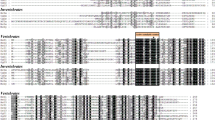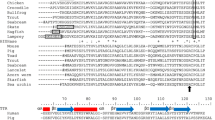Abstract
Iodothyronine deiodinase catalyzes the initiation and termination of thyroid hormones (THs) effects, and plays a central role in the regulation of thyroid hormone level in vertebrates. In non-chordate invertebrates, only one deiodinase has been identified in the scallop Chlamys farreri. Here, two deiodinases were cloned in the Pacific oyster Crassostrea gigas (CgDx and CgDy). The characteristic in-frame TGA codons and selenocysteine insertion sequence elements in the oyster deiodinase cDNAs supported the activity of them. Furthermore, seven orthologs of deiodinases were found by a tblastn search in the mollusk Lottia gigantea and the annelid Capitella teleta. A phylogenetic analysis revealed that the deiodinase gene originated from an common ancestor and a clade-specific gene duplication occurred independently during the differentiation of the mollusk, annelid, and vertebrate lineages. The distinct spatiotemporal expression patterns implied functional divergence of the two deiodinases. The expression of CgDx and CgDy was influenced by L-thyroxine T4, and putative thyroid hormone responsive elements were found in their promoters, which suggested that the oyster deiodinases were feedback regulated by TH. Epinephrine stimulated the expression level of CgDx and CgDy, suggesting an interaction effect between different hormones. This study provides the first evidence for the existence of a conserved TH feedback regulation mechanism in mollusks, providing insights into TH evolution.
Similar content being viewed by others
References
Barca-Mayo O, Liao X H, Alonso M, Di Cosmo C, Hernandez A, Refetoff S, Weiss R E. 2011. Thyroid hormone receptor α and regulation of type 3 deiodinase. Mol. Endocrinol., 25(4): 575–583.
Berry M J, Banu L, Harney J W, Larsen P R. 1993. Functional characterization of the eukaryotic secis elements which direct selenocysteine insertion at UGA codons. EMBO J., 12(8): 3 315–3 322.
Bianco A C, Salvatore D, Gereben B, Berry M J, Larsen P R. 2002. Biochemistry, cellular and molecular biology, and physiological roles of the iodothyronine selenodeiodinases. Endocr. Rev., 23(1): 38–89.
Coon S L, Bonar D B, Weiner R M. 1985. Induction of settlement and metamorphosis of the Pacific oyster, Crassostrea gigas (Thunberg), by l-Dopa and catecholamines. J. Exp. Mar. Biol. Ecol., 94(1–3): 211–221.
Croteau W, Davey J C, Galton V A, St Germain D L. 1996. Cloning of the mammalian type II iodothyronine deiodinase. A selenoprotein differentially expressed and regulated in human and rat brain and other tissues. J. C lini. I nvest., 98(2): 405–417.
Das B, Heimeier R A, Buchholz D R, Shi Y B. 2009. Identification of direct thyroid hormone response genes reveals the earliest gene regulation programs during frog metamorphosis. J. Biol. Chem., 284(49): 34 167–34 178.
Du Y S, Zhang L L, Xu F, Huang B Y, Zhang G F, Li L. 2013. Validation of housekeeping genes as internal controls for studying gene expression during Pacific oyster (Crassostrea gigas) development by quantitative realtime PCR. Fish Shellfish Immunol., 34(3): 939–945.
Fukazawa H, Hirai H, Hori H, Roberts R D, Nukaya H, Ishida H, Tsuji K. 2001. Induction of abalone larval metamorphosis by thyroid hormones. Fisheries Sci., 67(5): 985–987.
Heyland A, Price D A, Bodnarova-Buganova M, Moroz L L. 2006. Thyroid hormone metabolism and peroxidase function in two non-chordate animals. J. Exp. Zool. B Mol. Dev. Evol., 306B(6): 551–566.
Jakobs T C, Schmutzler C, Meissner J, Köhrle J. 1997. The promoter of the human type I 5′-deiodinase gene—mapping of the transcription start site and identification of a DR+4 thyroid-hormone-responsive element. Eur. J. Biochem., 247(1): 288–297.
Köhrle J. 2002. Iodothyronine deiodinases. Methods Enzymol., 347: 125–167.
Laudet V. 2011. The origins and evolution of vertebrate metamorphosis. Curr. Biol., 21(18): R726–R737.
Lobanov A V, Fomenko D E, Zhang Y, Sengupta A, Hatfield D L, Gladyshev V N. 2007. Evolutionary dynamics of eukaryotic selenoproteomes: large selenoproteomes may associate with aquatic life and small with terrestrial life. Genome Biol., 8(9): R198.
Mariotti M, Lobanov A V, Guigo R, Gladyshev V N. 2013. SECISearch3 and Seblastian: new tools for prediction of SECIS elements and selenoproteins. Nucleic Acids Res., 41(15): e149.
Morvan-Dubois G, Demeneix B A, Sachs L M. 2008. Xenopus laevis as a model for studying thyroid hormone signalling: From development to metamorphosis. Mol. Cell. Endocrinol., 293(1–2): 71–79.
Nakajima K, Fujimoto K, Yaoita Y. 2012. Regulation of thyroid hormone sensitivity by differential expression of the thyroid hormone receptor during Xenopus metamorphosis. Genes Cells, 17(8): 645–659.
Qu T, Huang B Y, Zhang L L, Li L, Xu F, Huang W, Li C Y, Du Y S, Zhang G F. 2014. Identification and functional characterization of two executioner caspases in Crassostrea gigas. PloS One, 9(2): e89040.
Roustaian P, Gaik L A. 2006. Effect of thyroxine immersion on larval survival, growth and postlarvae production of freshwater prawn, Macrobrachium rosenbergii (de Man). Aquac. Res., 37(13): 1 378–1 380.
Schweizer U, Schlicker C, Braun D, Kohrle J, Steegborn C. 2014. Crystal structure of mammalian selenocysteine-dependent iodothyronine deiodinase suggests a peroxiredoxin-like catalytic mechanism. Proc. Natl. Acad. Sci. USA, 111(29): 10 526–10 531.
Shepherdley C A, Klootwijk W, Makabe K W, Visser T J, Kuiper G G J M. 2003. An ascidian homolog of vertebrate iodothyronine deiodinases. Endocrinology, 145(3): 1 255–1 268.
Tata J R. 2006. Amphibian metamorphosis as a model for the developmental actions of thyroid hormone. Mol. Cell. Endocrinol., 246(1–2): 10–20.
Wu T T, Shi X W, Zhou Z, Wang L L, Wang M Q, Wang L L, Huang M M, Yang C Y, Song L S. 2012. An iodothyronine deiodinase from Chlamys farreri and its induced mRNA expression after LPS stimulation. Fish Shellfish Immunol., 33(2): 286–293.
Wu W J, Niles E G, Loverde P T. 2007. Thyroid hormone receptor orthologues from invertebrate species with emphasis on Schistosoma mansoni. BMC Evol. Biol., 7: 150.
Yen P M. 2001. Physiological and molecular basis of thyroid hormone action. Physiol. Rev., 81(3): 1 097–1 142.
Zavacki A M, Ying H, Christoffolete M A, Aerts G, So E, Harney J W, Cheng S Y, Larsen P R, Bianco A C. 2005. Type 1 iodothyronine deiodinase is a sensitive marker of peripheral thyroid status in the mouse. Endocrinology, 146(3): 1 568–1 575.
Zhang G F, Fang X D, Guo X M, Li L, Luo R B, Xu F, Yang P C, Zhang L L, Wang X T, Qi H G, Xiong Z Q, Que H Y, Xie Y L, Holland P W H, Paps J, Zhu Y B, Wu F C, Chen Y X, Wang J F, Peng C F, Meng J, Yang L, Liu J, Wen B, Zhang N, Huang Z Y, Zhu Q H, Feng Y, Mount A, Hedgecock D, Xu Z, Liu Y J, Domazet-Lošo T, Du Y S, Sun X Q, Zhang S D, Liu B H, Cheng P Z, Jiang X T, Li J, Fan D D, Wang W, Fu W J, Wang T, Wang B, Zhang J B, Peng Z Y, Li Y X, Li N, Wang J P, Chen M S, He Y, Tan F J, Song X R, Zheng Q M, Huang R L, Yang H L, Du X D, Chen L, Yang M, Gaffney P M, Wang S, Luo L H, She Z C, Ming Y, Huang W, Zhang S, Huang B Y, Zhang Y, Qu T, Ni P X, Miao G Y, Wang J Y, Wang Q, Steinberg C E W, Wang H Y, Li N, Qian L M, Zhang G J, Li Y R, Yang H M, Liu X, Wang J, Yin Y, Wang J. 2012. The oyster genome reveals stress adaptation and complexity of shell formation. Nature, 490(7418): 49–54.
Zhang J S, Lazar M A. 2000. The mechanism of action of thyroid hormones. Annu. Rev. Physiol., 62: 439–466.
Zhang L L, Li L, Zhang G F. 2011. Gene discovery, comparative analysis and expression profile reveal the complexity of the Crassostrea gigas apoptosis system. Dev. Comp. Immunol., 35(5): 603–610.
Author information
Authors and Affiliations
Corresponding authors
Additional information
Supported by the National Natural Science Foundation of China (Nos. 31372515, 31402285), the National Basic Research Program of China (973 Program) (No. 2010CB126401), and the National High Technology Research and Development Program (863 Program) (No. 2012AA10A405)
Rights and permissions
About this article
Cite this article
Huang, W., Xu, F., Qu, T. et al. Iodothyronine deiodinase gene analysis of the Pacific oyster Crassostrea gigas reveals possible conservation of thyroid hormone feedback regulation mechanism in mollusks. Chin. J. Ocean. Limnol. 33, 997–1006 (2015). https://doi.org/10.1007/s00343-015-4300-x
Received:
Accepted:
Published:
Issue Date:
DOI: https://doi.org/10.1007/s00343-015-4300-x




